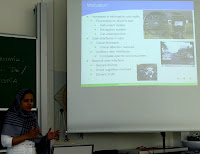It seems we have a lot of work in progress 🙂 and CHI is a great place to get feedback an talk to people about it.
Florian Alt and others from the summer school in Haifa pushed one of the ideas the developed there further. It is about interactions and technologies to motivate a more thoughtful handling of trash in urban areas [1].
Tanja Döring and Bastian Pfleging developed with Chris Kray in Nottingham the idea of tangible devices that have a functional core and a passive shell [2]. By this we image that future tangible products can be created by designers and developers with no need for the production of electronics. As a side effect this approach could make consumer electronics more sustainable – even if you like often new gadgets.
Together with people from DFKI Saarbrücken we explored the potential of a multi-touch steering wheel [3]. What gestures would you do to switch on your radio? How to interact with the navigation system? Such questions are empirically explored and presented in this paper.
How many people have a phone? How many people have a PC? It very clear more people have a phone than a PC and in particular in the non-industrial part of the world for many people the only computing technology available is the phone. We think there are ways to efficiently develop software using a phone for the phone. In the paper we explored a paper and computer vision based approach for software development on the phone [4].
Elba did field studies in Panama to assess the access of phones as educational tool to children [5]. She compared different parts of the country and did interviews with teachers.
[1] Reif, I., Alt, F., Hincapié Ramos, J., Poteriaykina, K., and Wagner, J. 2010. Cleanly: trashducation urban system. In Proceedings of the 28th of the international Conference Extended Abstracts on Human Factors in Computing Systems (Atlanta, Georgia, USA, April 10 – 15, 2010). CHI EA ’10. ACM, New York, NY, 3511-3516. DOI= http://doi.acm.org/10.1145/1753846.1754010
[2] Doering, T., Pfleging, B., Kray, C., and Schmidt, A. 2010. Design by physical composition for complex tangible user interfaces. In Proceedings of the 28th of the international Conference Extended Abstracts on Human Factors in Computing Systems (Atlanta, Georgia, USA, April 10 – 15, 2010). CHI EA ’10. ACM, New York, NY, 3541-3546. DOI= http://doi.acm.org/10.1145/1753846.1754015
[3] Pfeiffer, M., Kern, D., Schöning, J., Döring, T., Krüger, A., and Schmidt, A. 2010. A multi-touch enabled steering wheel: exploring the design space. In Proceedings of the 28th of the international Conference Extended Abstracts on Human Factors in Computing Systems (Atlanta, Georgia, USA, April 10 – 15, 2010). CHI EA ’10. ACM, New York, NY, 3355-3360. DOI= http://doi.acm.org/10.1145/1753846.1753984
[4] Pfleging, B., Valderrama Bahamondez, E. d., Schmidt, A., Hermes, M., and Nolte, J. 2010. MobiDev: a mobile development kit for combined paper-based and in-situ programming on the mobile phone. In Proceedings of the 28th of the international Conference Extended Abstracts on Human Factors in Computing Systems (Atlanta, Georgia, USA, April 10 – 15, 2010). CHI EA ’10. ACM, New York, NY, 3733-3738. DOI= http://doi.acm.org/10.1145/1753846.1754047
[5] Valderrama Bahamóndez, E. d. and Schmidt, A. 2010. A survey to assess the potential of mobile phones as a learning platform for panama. In Proceedings of the 28th of the international Conference Extended Abstracts on Human Factors in Computing Systems (Atlanta, Georgia, USA, April 10 – 15, 2010). CHI EA ’10. ACM, New York, NY, 3667-3672. DOI= http://doi.acm.org/10.1145/1753846.1754036








































